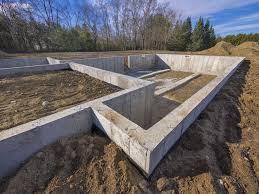
When you are building a new home, you first should decide what type of foundation you need. Your foundation needs to support the house, keep groundwater out, and block water vapor and/or soil gas. These requirements apply to any foundation and "make or break" a foundation's usefulness.
The first choice for foundations is a slab foundation. It is laid directly on the ground with no crawlspace, beams, or basement. These foundations are popular with builders and homeowners because they are relatively inexpensive and hasten construction. But, with a slab foundation, there is no room underneath for plumbing or air-conditioning systems. Any problems you have with these systems will require foundation removal to access components. This makes the repairs more expensive and time-consuming.
The second option for foundations is a crawl space. Foundations like these (crawl spaces) is not one solid sheet of concrete, but short foundation walls around the perimeter of the foundation. This foundation will save money, but there is no time saved compared to other foundations. Crawl spaces make utilities accessible because the crawl space is the floor for the home above. In addition, to control mold issues, there should be a vapor barrier on top of the soil in the crawl space. This kind of foundation usually eliminates issues associated with slab foundations, but they offer little protection in storms.
A third option for foundations is a basement and walk out. In cold climates, the frost line is deep and homes have basements. If you dig deep enough to support the house, it will not cost much more to add living space, like a basement. Basements can be functional and worth the money. If you build a small home, you will like the added space a basement will provide, such as living space and storage capacity.
A fourth option is a pier foundation. The foundation's have small pads of concrete located around the building at strategic points. The pads are put in the ground and have vertical posts connected to the building via horizontal beams. This kind of foundation is used on lots where typical foundations are hard to lay. For bigger structures, more posts and pads can be added inside the foundation for added support.
Any foundation will work for your home-some will work better than others when applied to your specific needs and requirements. Given the choices available, it might behoove you to discuss the options with your contractor to get a professional opinion. Your contractor can help guide and inform you, helping you make a better decision about your home's foundation.

